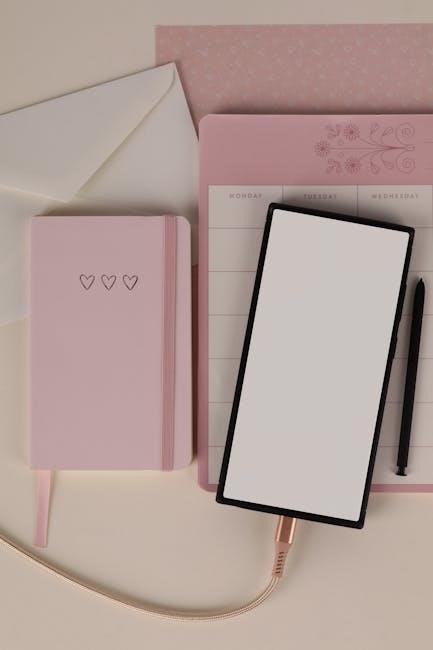informational writing graphic organizer pdf free

Graphic organizers are visual tools that help students structure and organize ideas for informational writing. They provide a clear framework for topic sentences, facts, details, and conclusions, making the writing process more manageable and effective. These organizers are particularly useful for expository essays, compare-and-contrast assignments, and cause-and-effect analyses. Many free PDF templates are available online, offering customizable layouts to suit different grade levels and writing projects. Teachers and students can easily download and print these resources to enhance writing skills and promote better organization of information.
What is an Informational Writing Graphic Organizer?
An informational writing graphic organizer is a visual tool designed to help students structure and organize ideas for writing projects. It typically includes sections for a title, topic sentence, facts, details, and a conclusion, providing a clear framework for arranging information. These organizers are particularly useful for expository essays, compare-and-contrast assignments, and cause-and-effect analyses. Many free PDF templates are available online, offering customizable layouts to suit different grade levels and writing projects. Teachers and students can easily download and print these resources to enhance writing skills and promote better organization of information;
The Purpose of Graphic Organizers in Writing
Graphic organizers serve as essential tools to guide students in brainstorming, organizing, and structuring their ideas for informational writing. They help students break down complex topics into manageable parts, ensuring clarity and coherence in their writing. By providing a visual framework, these organizers make it easier for students to categorize information, identify relationships between ideas, and maintain a logical flow. They are particularly effective for helping students transition from pre-writing to drafting, as they offer a clear roadmap for constructing essays, reports, and other written assignments. This structured approach fosters better writing habits and improves overall academic performance.
Benefits of Using Graphic Organizers for Students
Graphic organizers offer numerous benefits for students, enhancing their writing skills and organizational abilities. They provide a clear structure for brainstorming, allowing students to visually map out ideas and facts before writing. This tool improves coherence and logical flow in essays, making it easier for students to connect ideas. Graphic organizers also help students identify gaps in their knowledge, encouraging deeper research and understanding. Additionally, they build confidence by offering a step-by-step approach to writing, reducing anxiety and making the writing process more manageable. Overall, these organizers are invaluable for fostering better writing habits and academic success across all grade levels.

Key Features of an Effective Informational Writing Graphic Organizer
A well-designed graphic organizer includes a structured layout with sections for topic sentences, facts, details, and conclusions. It often features customizable templates and downloadable PDF formats, ensuring flexibility for various writing topics and student needs.
Structure for Organizing Ideas
A effective graphic organizer for informational writing includes a clear structure to help students organize their ideas logically. It typically features sections for a main idea, supporting facts, and details, guiding students to break down their topic into manageable parts. This structure ensures that students can visually map out their essay, making it easier to understand the flow of information.
Visual elements like charts, diagrams, or boxes are often used to separate different components of the writing process, such as introductions, body paragraphs, and conclusions. This visual separation helps students see how ideas connect and ensures their writing is coherent and well-structured.
Sections for Topic Sentences and Facts
Graphic organizers for informational writing often include dedicated sections for topic sentences and supporting facts. These sections help students clearly define their main ideas and organize relevant information. For example, a template might have boxes labeled for a topic sentence, followed by three facts with details beneath each. This structure ensures that students can easily identify and separate their main ideas from the supporting evidence, making it easier to develop well-structured paragraphs. The clear separation of ideas also helps students maintain focus and ensure their writing stays on topic, leading to more coherent and logically organized essays.
Spaces for Details and Conclusions
Graphic organizers typically include specific spaces for details and conclusions to help students elaborate on their facts and summarize their writing effectively. These sections allow students to expand on their main ideas by providing supporting details, examples, or explanations. The conclusion section guides students in wrapping up their writing by restating the topic sentence and summarizing the key points. Having dedicated spaces for details and conclusions ensures that students can organize their thoughts logically and maintain a clear structure in their writing. This feature is especially helpful for young writers who are learning to develop and conclude their ideas coherently.

How to Choose the Right Graphic Organizer for Your Needs
Consider the age, grade level, and writing type when selecting a graphic organizer. Choose templates that align with the specific topic and writing style of your project.
Considering the Age and Grade Level of Students
When selecting a graphic organizer, it’s essential to consider the age and grade level of students. Elementary students benefit from simple, visually appealing templates with clear sections for topic sentences and facts. Middle school students may require more detailed structures to organize evidence and analysis. High school students often need advanced layouts to handle complex topics and multiple sources. Customizable PDF templates allow teachers to tailor organizers to meet the developmental needs of their students, ensuring the tool is both effective and engaging for their specific grade level. This adaptability helps students develop strong writing skills at every stage of their education.
Selecting Organizers Based on Writing Type
Choosing the right graphic organizer depends on the type of writing assignment. For expository essays, organizers with sections for introduction, body paragraphs, and conclusion are ideal. Compare-and-contrast tasks benefit from Venn diagrams or chart-style organizers to highlight similarities and differences. Cause-and-effect writing may use flowcharts or concept maps to show relationships between events. Teachers can find free PDF templates specifically designed for these writing types, ensuring students have the appropriate structure to organize their ideas effectively. Selecting organizers that match the writing task helps students stay focused and ensures their work is well-structured and coherent from start to finish.
Customization Options for Specific Topics
Graphic organizers can be tailored to fit specific topics, allowing students to focus on relevant information. For example, science topics might use organizers with sections for hypotheses and data, while historical events could include timelines and cause-effect sections; Many free PDF templates offer editable fields, enabling teachers to adapt them to particular subjects or themes. Some organizers also allow students to personalize the layout by adding images or diagrams, making the learning experience more engaging. Customization ensures that the organizer aligns with the topic, helping students to organize their thoughts more effectively and produce focused, detailed writing.

Free Printable Graphic Organizers for Informational Writing
Free printable graphic organizers are widely available online, offering structured templates for informational writing. These PDF resources help students organize ideas, topic sentences, facts, and conclusions effectively.
Popular Websites Offering Free Downloads
Several websites provide free downloadable graphic organizers for informational writing. Teachers Pay Teachers offers a variety of free PDF templates designed for different grade levels and writing projects. Education.com and Pinterest also feature extensive collections of printable graphic organizers tailored for expository essays, compare-and-contrast assignments, and cause-and-effect analyses. These resources are easily accessible, saving time for educators and students. Many templates are customizable, allowing teachers to adapt them to specific topics or classroom needs. These websites are invaluable for enhancing the writing process and helping students organize their ideas effectively.
How to Download and Print PDF Templates
Downloading and printing PDF templates for informational writing graphic organizers is straightforward. Visit websites like Teachers Pay Teachers or Education.com, search for “informational writing graphic organizer PDF free,” and select the desired template. Click the download button, usually labeled as “Download” or “Free Download.” Once downloaded, open the PDF file using Adobe Acrobat or similar software. Print the template on standard paper for immediate use. Some websites may require creating a free account to access downloads. Ensure your printer settings match the template’s layout for optimal results. This process allows teachers and students to quickly access and utilize these tools for writing projects.
Editable vs. Non-Editable Formats
When selecting graphic organizers, teachers can choose between editable and non-editable formats. Editable templates, often in Word Doc format, allow customization, enabling users to tailor the organizer to specific topics or classroom needs. This flexibility is ideal for adapting content to different subjects or grade levels. Non-editable formats, typically PDFs, are ready to print and use, offering a quick solution for immediate implementation. While PDFs are convenient, they lack the ability to modify content, making them suitable for general use. Teachers should consider their specific needs when deciding between these formats to maximize the effectiveness of the graphic organizer in the classroom.

Using Graphic Organizers for Different Writing Projects
Graphic organizers are versatile tools that help students structure essays, compare-and-contrast assignments, and cause-and-effect analyses. They provide a clear framework for organizing ideas, enhancing clarity and promoting effective writing skills.
Expository Essays and Informative Writing
Graphic organizers are invaluable for structuring expository essays and informative writing. They provide a clear framework for brainstorming, organizing, and outlining ideas. Students can use these tools to break down their writing into introduction, body paragraphs, and conclusion. Organizers often include sections for topic sentences, supporting facts, and detailed explanations, helping students maintain coherence. Free PDF templates are widely available online, offering customizable layouts tailored to various writing projects. These resources guide students in comparing and contrasting ideas, analyzing cause and effect, and creating structured essays. By using graphic organizers, students can effectively communicate their thoughts and produce well-organized, informative writing pieces.
Compare and Contrast Assignments
Graphic organizers are particularly effective for compare and contrast assignments, as they help students visually identify similarities and differences. These tools often feature side-by-side columns or Venn diagrams, allowing students to categorize information and organize evidence. By structuring ideas in this way, students can develop clear arguments and make meaningful comparisons. Free PDF templates are available online, offering customizable layouts for various topics. These organizers guide students in brainstorming, outlining, and drafting their essays, ensuring a logical flow of ideas. They are especially useful for teaching students how to analyze and present information coherently in comparative writing tasks.
Cause and Effect Analysis
Graphic organizers are invaluable for teaching cause and effect analysis, helping students map relationships between events and their outcomes. These tools often feature flowcharts or diagrams that visually connect causes and effects. Free PDF templates, such as cause-and-effect charts, enable students to brainstorm and organize ideas systematically. By breaking down complex relationships, graphic organizers simplify the writing process, making it easier for students to structure coherent paragraphs. Many templates are available online, offering adaptable designs for various topics and grade levels. This visual approach enhances understanding and supports students in crafting clear, logical arguments for their informational writing assignments.

Step-by-Step Guide to Filling Out a Graphic Organizer
Begin with brainstorming to generate ideas, then organize facts and details into designated sections. Finally, transfer ideas to a rough draft using the structured format provided.
Brainstorming and Idea Generation
Brainstorming is the first step in using a graphic organizer for informational writing. Students start by generating ideas related to their topic, which helps them explore different angles and perspectives. This stage encourages creativity and ensures that all relevant information is considered. By jotting down key points, students can visualize connections between ideas and identify areas that need more development. Graphic organizers often include dedicated spaces for brainstorming, allowing students to categorize and prioritize their thoughts effectively. This process lays a solid foundation for organizing facts and details, making the writing process more structured and focused from the outset.
Organizing Facts and Details
After brainstorming, students use graphic organizers to categorize and structure their facts and details. Dedicated sections for topic sentences, facts, and supporting details help maintain clarity. Students can place each fact in separate boxes, then fill in relevant details beneath them. This visual arrangement prevents overcrowding and ensures each idea is distinct. Linking facts back to the topic sentence reinforces the essay’s focus. Free PDF templates often include labeled sections, making it easy for students to organize information logically. This step transforms raw ideas into a coherent structure, ready for drafting. Proper organization enhances readability and ensures all key points are included in the final write-up.
Transferring Ideas to a Rough Draft
Once ideas are organized in the graphic organizer, students can seamlessly transfer them to a rough draft. The structured format ensures that topic sentences, facts, and details are logically arranged. Students expand each section into full sentences, maintaining the flow from introduction to conclusion. The organizer acts as a blueprint, guiding the writing process and preventing essential points from being overlooked. This step reinforces the connection between planning and execution, helping students produce a coherent and well-organized draft. Free PDF templates often include spaces for drafts, making the transition from planning to writing straightforward and efficient for students of all skill levels.

Teaching Strategies for Implementing Graphic Organizers
Effective teaching strategies involve using free PDF graphic organizers to structure writing projects, enhance idea organization, and provide clear frameworks for students to follow successfully.
Classroom Activities to Introduce Organizers
Introducing graphic organizers in the classroom can be engaging and effective. Start with a mentor text, such as a sample essay, and have students highlight key information they want to use. Then, distribute a free PDF graphic organizer template and guide students in filling it out together. This collaborative approach helps students understand how to classify ideas and structure their writing. Pair students to brainstorm topics and organize their thoughts using the template. Finally, allow time for sharing and feedback, ensuring everyone grasps how to use these tools independently for future writing projects.
Modeling the Use of Graphic Organizers
Modeling is a powerful strategy to teach students how to use graphic organizers effectively. Teachers can start by projecting a sample PDF template and walking through each section step-by-step; For example, demonstrate how to write a topic sentence, list supporting facts, and add details. Use a mentor text or a simple topic to fill out the organizer together as a class. This visual and interactive approach helps students see how ideas are structured and connected. Encourage questions and discussions during the process to clarify any confusion. By modeling, teachers provide a clear roadmap, making it easier for students to apply the organizer independently.
Providing Feedback and Guidance
Providing constructive feedback and guidance is essential to help students effectively use graphic organizers for informational writing. Teachers should review completed organizers, highlighting strengths and areas for improvement. Clear expectations and examples help students understand how to structure their ideas. Offering one-on-one support allows for personalized feedback, ensuring students grasp the purpose of each section. Encouraging peer review can also foster collaboration and mutual understanding. By guiding students through the process, teachers empower them to use graphic organizers confidently and independently, enhancing their writing skills and organizational abilities. Regular feedback helps refine their use of these tools over time.

Examples of Free Graphic Organizer Templates
Explore various free PDF templates designed for informational writing, including basic layouts for elementary students, advanced structures for middle and high school, and specialized subject-focused designs. These adaptable templates cater to diverse learning needs, offering customizable sections for topics, facts, and conclusions. Ideal for expository essays, compare-and-contrast, and cause-and-effect writing, they provide a structured approach to organizing ideas effectively.
Basic Templates for Elementary Students
Basic graphic organizer templates are designed for young learners, simplifying the writing process with clear sections for titles, topic sentences, facts, details, and conclusions. These templates use large fonts and ample spacing, making them easy for elementary students to navigate. They often include visual cues and simple language to guide students in organizing their thoughts logically. Teachers can print these free PDF templates, providing students with a structured yet engaging way to develop foundational writing skills. These tools are ideal for introducing informational writing concepts, helping students build confidence and clarity in their early writing experiences.
Advanced Templates for Middle and High School
Advanced graphic organizer templates are designed for older students, offering detailed sections for complex writing tasks. These templates include spaces for multiple facts, detailed explanations, evidence, and analysis, catering to the needs of middle and high school students. They often feature prompts for thesis statements, supporting arguments, and sophisticated conclusions. Many advanced templates are adaptable for various subjects, such as history, science, or literature, and can be used for expository essays, compare-and-contrast assignments, or cause-and-effect analyses. Teachers can download free PDF versions of these templates, providing students with structured tools to enhance critical thinking and writing skills at higher grade levels.
Specialized Templates for Different Subjects
Specialized graphic organizers are tailored to meet the unique demands of various academic subjects. For science, they may include sections for hypotheses, observations, and conclusions. History-focused templates might have areas for timelines, events, and analyses. Language arts organizers often emphasize literary elements, themes, and character development. These subject-specific tools help students organize information relevant to their assignments, ensuring clarity and coherence in their writing. Many websites offer free PDF downloads of these specialized templates, allowing teachers to provide resources that align with specific curriculum requirements and enhance students’ ability to explore complex topics in depth across different disciplines.

Why Teachers Prefer PDF Formats for Graphic Organizers
Teachers prefer PDF graphic organizers for their ease of sharing, printing, and compatibility across devices. They offer professional, clean layouts, enhancing the writing process.
Ease of Sharing and Printing
PDF graphic organizers are widely preferred due to their ease of sharing and printing. Teachers can quickly distribute them via email or learning platforms, ensuring all students have access. Printing is straightforward, as PDFs maintain their formatting across devices, avoiding layout issues. This consistency is crucial for clarity, especially for young learners. Additionally, PDFs can be printed in large quantities, making them ideal for classroom use. The universal compatibility of PDFs ensures that educators can share resources effortlessly, regardless of the device or software students use. This accessibility makes PDF graphic organizers a practical choice for educational settings.
Compatibility Across Devices
PDF graphic organizers are compatible across various devices, ensuring accessibility for all users. Whether accessed on a desktop, laptop, tablet, or smartphone, PDFs maintain their formatting and clarity. This universal compatibility allows teachers and students to view and print organizers without issues, regardless of the device used. PDFs can be opened with free readers like Adobe Acrobat, making them accessible to everyone. This feature is particularly beneficial for remote learning, as educators can share resources knowing they will display correctly on any device. The consistent layout ensures that the graphic organizer’s structure remains intact, providing a seamless experience for all users.
Professional and Clean Layouts
PDF graphic organizers for informational writing are designed with professional and clean layouts, enhancing readability and user experience. These templates feature well-structured sections with clear headings, ample spacing, and logical flow. The clean design helps students focus on content without visual clutter, making it easier to organize ideas. Teachers appreciate the professional appearance, which aligns with educational standards. Many free PDF templates are created by educators, ensuring they meet classroom needs. The polished look of these organizers also makes them suitable for printing and sharing, providing a professional touch to teaching materials and student work. This design simplicity supports effective learning and instruction.

Common Mistakes to Avoid When Using Graphic Organizers
Common mistakes include overloading with too much information, not tailoring organizers to specific topics, and skipping the brainstorming step, which can hinder clarity and effectiveness.
Overloading with Too Much Information
Overloading a graphic organizer with excessive details can make it cluttered and confusing, hindering its purpose. Students should focus on key ideas and supporting facts rather than including every piece of information. Encourage them to prioritize relevance and clarity. Using concise language and avoiding unnecessary details helps maintain organization. Teachers should guide students to review and refine their content, ensuring the organizer remains a useful tool for structured writing. This approach prevents overwhelm and keeps the focus on essential elements, making the writing process more efficient and effective for students of all grade levels.
Not Tailoring to Student Needs
Using a one-size-fits-all graphic organizer can be counterproductive, as it may not meet the unique needs of individual students. Teachers should consider the age, skill level, and learning style of their students when selecting or customizing organizers. For example, younger students may need simpler templates with clear sections, while older students might benefit from more complex layouts. Failing to tailor organizers can lead to confusion or frustration, especially for those who require additional support. Customizable PDF templates are ideal, as they allow teachers to adapt the design and content to suit specific topics or student requirements, ensuring a more effective learning experience.
Skipping the Brainstorming Step
Skiping the Brainstorming Step
Skiping the brainstorming step can lead to poorly organized and vague content in informational writing. Graphic organizers are designed to structure ideas, but without brainstorming, students may struggle to generate meaningful information to fill them out. This can result in disorganized writing and a lack of depth in the final draft. Brainstorming helps students generate and organize ideas before writing, ensuring their graphic organizer is filled with relevant and coherent content. Skipping this step often leads to unclear topic sentences, unsupported facts, and weak conclusions. Encourage students to spend time brainstorming to maximize the effectiveness of their graphic organizer and improve the overall quality of their writing.
Graphic organizers are essential tools for streamlining informational writing, offering structured frameworks for ideas. Free PDF templates provide accessible resources for teachers and students, fostering clear, well-organized writing.
The Importance of Graphic Organizers in Education
Graphic organizers play a vital role in education by providing students with a structured approach to writing and learning. They help students organize ideas, classify information, and visually map out concepts, which enhances comprehension and retention. For informational writing, these tools are especially beneficial as they guide students in developing clear topic sentences, supporting facts, and logical conclusions. The availability of free, downloadable PDF templates makes it easier for educators to integrate these resources into their classrooms, ensuring that students across all grade levels can benefit from improved writing and critical thinking skills. This accessibility fosters academic success and independent learning.
Encouraging Better Writing Habits
Graphic organizers are invaluable tools for fostering better writing habits in students. By providing a structured framework, they help students break down complex writing tasks into manageable parts, such as brainstorming ideas, organizing facts, and drafting conclusions. This structured approach reduces writing anxiety and encourages students to think critically about their content. Free PDF templates, easily downloadable and printable, offer educators and students accessible resources to improve writing skills. Regular use of graphic organizers teaches students to plan and revise their work effectively, promoting independence and confidence in their writing abilities over time.
Accessibility of Free Resources for Teachers
Free graphic organizer templates for informational writing are widely available online, making it easy for teachers to access and utilize these tools. Websites offer downloadable PDFs and editable formats, catering to various grade levels and writing types. These resources are compatible with multiple devices, ensuring flexibility for both in-class and remote learning. Teachers can print or share these organizers effortlessly, saving time and resources. The availability of free, professional-grade templates allows educators to provide students with structured writing guides without additional costs, promoting equitable access to quality educational tools.